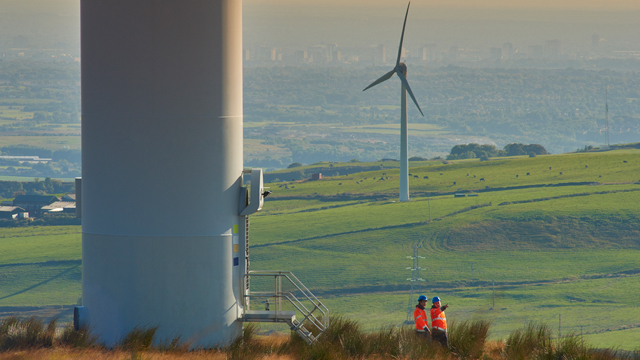
Fact or fiction: is clean energy too expensive and not reliable?
There are lots of myths surrounding clean energy – here we separate fact from fiction.
As we transition to a cleaner, greener future, more of our energy will come from renewable sources. In the UK, to transport this clean energy from where it will be generated to the homes and businesses that need it, we need to overhaul the electricity grid to make it future proof – we call our plan for this The Great Grid Upgrade.
However, there are any number of myths surrounding both clean energy and the upgrading of the grid. We take a look at the most common misconceptions.

1: Is clean energy more expensive?
Despite there being a perception that ‘greener’ energy is more expensive, a recent study by RMI revealed that solar and wind energy are now the most affordable sources of new electricity in 82% of the world.
Last summer, the government boosted the claim that solar and wind are becoming ever cheaper than gas, which rose in price substantially following Russia’s invasion of Ukraine. The Department for Energy Security and Net Zero’s most recent projections for Britain state that solar output cost now averages £41 per megawatt hour (MWh) from new projects. For new gas power stations, the equivalent lifetime costs will be close to £114 per MWh.
“The Great Grid Upgrade will help address the issue of rising energy costs,” said Tom McGarry, our Deputy External Affairs Director. “The main cause of the recent hikes in energy bills is the volatility of the commodity cost of gas, caused by the conflict in Ukraine. Having more renewables connected to the UK energy system will help overcome the price spikes we have seen recently, ensuring bills are more affordable in the long-term.”
2: Aren’t clean energy sources unreliable?
There is a wide misconception that clean energy generation stops on cloudy days or when there isn’t much wind. While it’s true that there are some days when we don’t have any wind power, high-voltage undersea cables, known as interconnectors, connect the electricity systems of neighbouring countries and allow them to share surplus power, therefore adding to the UK’s energy mix. This ensures that renewable energy isn’t wasted and makes for a greener, more efficient power system.
In the future there will also be a greater opportunity for solar and wind power to be stored in batteries or storage plants, and nuclear power has an important part in the clean energy mix too.
It also tends to be windiest during the winter months, so wind turbines are producing more power at the time of year when we’re using the most electricity.
3: Can clean energy meet the UK’s electricity demand?
As the UK decreases its reliance on fossil fuels, we’ll all soon be using more electricity than ever and clean energy is a bountiful source for this. Just one rotation of the blades on a turbine at Dogger Bank – the world's largest offshore wind farm – can produce enough clean energy to power an average UK home for two days.
In fact, due to improvements in energy efficiency, the UK’s peak demand has actually fallen by 16% since 2002.

4: Doesn’t electricity infrastructure have a negative effect on biodiversity?
It’s natural that people are concerned about new infrastructure and how it might affect biodiversity, but a transition focused on wind and solar energy can result in significantly reduced environmental impact compared to other energy types.
A report by Chris Baines, leading environmentalist and independent chair of the Visual Impact Provision Stakeholder Advisory Group, found that we are “uniquely placed to play a key role in strengthening the ecological network through changes to the land management along the corridors that its power transmission routes occupy”.
The contractual relationship between National Grid and the great variety of different land managers is "of particular value in future biodiversity partnerships,” reports Chris, adding that "the current programme of new electricity transmission infrastructure" offers a "positive opportunity for National Grid to contribute to landscape restoration and biodiversity net-gain on a huge scale".
We hope that the steady transition to renewable energy will offer a chance to reset the relationship between energy production and nature, and we’ve set ourselves a target of delivering a net gain of at least 10% in environmental value, including biodiversity. This means that the areas where our work takes place will have a better-quality natural habitat than before development started.
5: Won’t new clean energy infrastructure take up too much space?
Energy infrastructure of any sort inevitably takes up some space, but clean energy doesn’t need disproportionate amounts of it. For example, a wind turbine footprint is small and leaves the surrounding land available for other uses, such as agriculture. Their total land footprint is often smaller still when you consider the extraction, transportation and processing activities needed for fossil fuels.
We don’t operate the infrastructure for generating renewable energy, but there are concerns about the scale of the transmission infrastructure, which we do operate, and how much of it is required for The Great Grid Upgrade. We do consider technology options when developing our projects, including the use of undergrounding of cables where appropriate – particularly in designated landscapes like areas of outstanding natural beauty – and mitigation is at the heart of our relationship with affected locations.
6: Are underground and subsea cables cheaper than overhead lines for transporting electricity?
As an electricity transmission owner, we have licence and regulatory obligations to be economical and efficient. The government’s planning policy advises that overhead lines should be the strong starting presumption for electricity network developments in general, except where a proposed development will cross parts of a nationally designated landscape.
Costs of alternative technologies to overhead lines can be significantly higher, with the undergrounding of cables around five to ten times more expensive.
The cost of offshore solutions – cables under the sea – is also significant and there is no fully offshore solution to connect offshore wind to the grid in any country – the network infrastructure has to be brought onto land somewhere. We investigated this for the East Anglia region and the cost to consumers of delivering an equivalent offshore cabling solution would be around four times the cost of an onshore overhead line option.
7: Is The Great Grid Upgrade just about getting more power to London?
While there are people that assume that projects like The Great Grid Upgrade are particularly focused on the capital, that’s simply not the case.
Our plan for upgrading the UK’s electricity grid includes proposals for infrastructure all over the country; for example, building a new high-voltage transmission line between East Yorkshire and Nottinghamshire, a high-voltage electricity link between Suffolk and Kent, and an overhead line in Lincolnshire.
The grid is a network and the electricity generated is distributed all over the country with 80% of the UK’s electricity demand outside of London – the new infrastructure is therefore vital for the whole country.
8: Things are fine as they are – why does the grid need an upgrade?
To help the UK transition to a clean energy future, we need to build five times more electricity transmission infrastructure over the next six years than has been constructed over the past three decades.
The UK’s electricity grid was originally built to connect the coal- and gas-fired power stations that were built on the coal seams that ran down the centre of the country through the industrial heartlands of the north of England and the Midlands. As we're getting more and more power from renewable sources, principally offshore, that now needs to change. So significant new infrastructure is needed to connect that renewable energy from where it’s generated to where it’s needed by UK homes and businesses.
The Great Grid Upgrade will allow the electricity grid to carry more clean energy to communities in every part of England and Wales, helping the UK reach its net zero target faster as well as increasing the supply of homegrown energy.
Find out more about The Great Grid Upgrade
More on The Great Grid Upgrade
What will upgrading the UK’s energy system mean for you?
Our electricity grid has served us for almost 90 years now. However, as we move from fossil fuels to cleaner energy sources this grid, the grid needs an upgrade. How will this happen and what will it mean for you?
How is the UK’s electricity grid being transformed?
The way electricity is used in the UK is constantly and rapidly changing. Combined with work towards clean energy goals, things never stand still for our electricity grid. So, how are we making sure our system is future proof?

